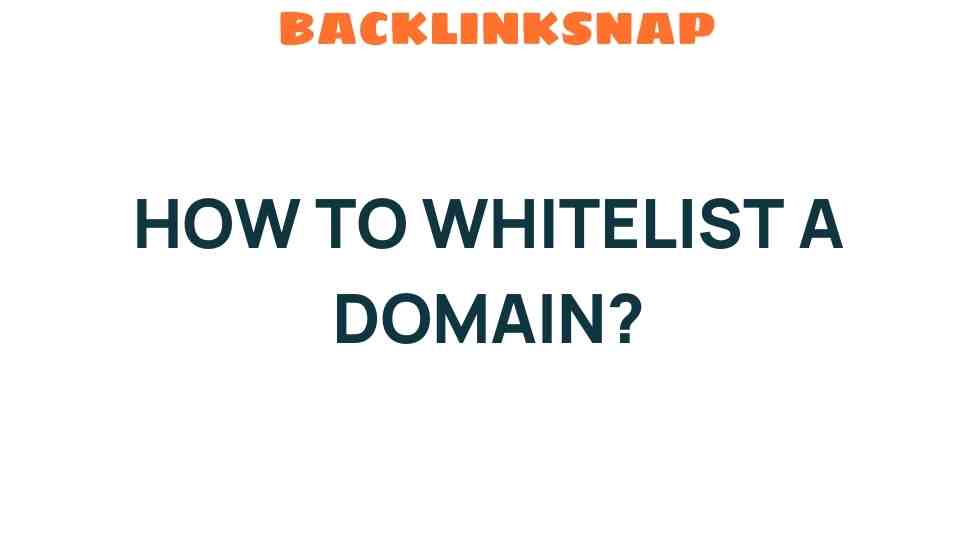Unlocking the Secrets: How to Whitelist a Domain Effectively
In the realm of cybersecurity, whitelisting is a vital practice that enhances domain security and online safety. For organizations and individuals alike, understanding how to properly whitelist domains can be the difference between a secure digital environment and a vulnerable one. This comprehensive guide will walk you through the intricacies of whitelisting while providing actionable insights based on firsthand experiences and industry best practices.
What is Whitelisting?
Whitelisting is the process of allowing specific entities—like domains, IP addresses, or applications—while blocking all others by default. In the context of domain security, whitelisting involves specifying which domains are trusted and safe for interaction. This approach is particularly useful in scenarios involving email filters, network access, and web permissions.
Why Whitelist Domains?
The growing sophistication of cyber threats makes it imperative for organizations to implement robust security measures. Whitelisting offers several advantages:
- Enhanced Security: By allowing only trusted domains, you minimize exposure to phishing attacks and malware.
- Controlled Access: It enables IT administrators to dictate which resources can be accessed, reducing the risk of insider threats.
- Improved Efficiency: Whitelisting can help streamline network traffic, enhancing performance by reducing unnecessary data loads.
How to Whitelist a Domain Effectively
Whitelisting a domain might seem daunting at first, but it can be broken down into manageable steps. Here’s how to do it effectively:
1. Identify the Domains to Whitelist
Begin by listing the domains that are essential for your operations. This may include domains used for communication, collaboration, or critical business applications. Be thorough; consider all departments and functions within your organization.
2. Understand Your Security Policies
Before whitelisting, review your organization’s security policies. This ensures that the domains you intend to allow align with your overall risk management strategies. It’s essential to maintain a balance between security and accessibility.
3. Implement Whitelisting in Email Filters
Many organizations rely heavily on email for communication. To whitelist a domain in your email system:
- Access your email settings.
- Look for “Spam” or “Filters” options.
- Add the specific domain to your whitelist.
This action will ensure that emails from that domain bypass spam filters, allowing for seamless communication.
4. Configure Network Access
For network security, configure your firewall or router settings to allow traffic from the whitelisted domains:
- Log into your network management interface.
- Navigate to the firewall settings.
- Add the domains to the permitted list.
Following this step will prevent unauthorized access while allowing trusted traffic.
5. Review and Update Regularly
Domain whitelisting is not a one-time task. Regular reviews are necessary to ensure that your whitelists remain relevant. Remove any domains that are no longer in use and add new ones as required. This ongoing process helps maintain online safety and operational efficiency.
6. Monitor for Anomalies
After whitelisting, keep an eye on network traffic and email communications for any irregularities. Implementing monitoring tools can help you detect unusual patterns, which might indicate that a whitelisted domain has been compromised.
Common Challenges in Whitelisting
While whitelisting can significantly improve security, it isn’t without its challenges:
- Over-reliance on Whitelists: Solely depending on whitelisting can lead to complacency. Always layer security measures.
- Maintenance Overhead: Regular updates require time and resources, which can be a burden for smaller organizations.
- False Sense of Security: Just because a domain is whitelisted doesn’t mean it’s immune to threats. Continuous vigilance is necessary.
Best Practices for Effective Whitelisting
To make the most out of your whitelisting efforts, consider these best practices:
- Implement a Least Privilege Model: Only whitelist domains that are absolutely necessary for your operations.
- Educate Employees: Ensure that all staff members understand the importance of whitelisting and how to identify suspicious activity.
- Use a Centralized Management Tool: This can simplify the process of managing whitelists across your organization.
Conclusion
Whitelisting is a powerful tool in the arsenal of IT management and cybersecurity. By effectively controlling which domains are deemed safe, organizations can significantly reduce their vulnerability to cyber threats. As you embark on your whitelisting journey, remember that this is an ongoing process that requires diligence and regular updates. With the right approach, you can enhance your organization’s security posture and foster a safer online environment.
FAQs
1. What is the difference between whitelisting and blacklisting?
Whitelisting allows only specified entities, while blacklisting blocks specific entities. Whitelisting is generally considered more secure, as it defaults to blocking everything except the trusted domains.
2. Can I whitelist a domain in multiple applications?
Yes, you can and should whitelist a domain across all relevant applications—email, web browsers, and any other platforms that interact with external domains.
3. How often should I review my whitelists?
It’s recommended to review your whitelists at least quarterly, or whenever there are significant changes in your organization’s operations.
4. What if a whitelisted domain gets compromised?
If a whitelisted domain is compromised, immediately remove it from the whitelist, and investigate any potential breaches or data loss.
5. Are there automated tools for whitelisting?
Yes, many cybersecurity platforms offer automated whitelisting features that can streamline the process and reduce administrative overhead.
6. Is whitelisting enough for cybersecurity?
While whitelisting is an effective security measure, it should be part of a multi-layered security strategy that includes firewalls, antivirus software, and employee training.
For more insights on cybersecurity practices, check out this Cybersecurity Resource.
For further reading on best practices in IT management, visit our IT Management Guide.
This article is in the category Digital Marketing and created by BacklinkSnap Team




